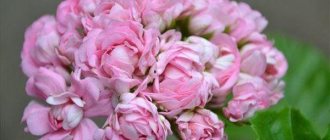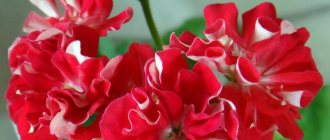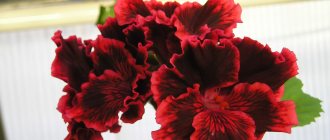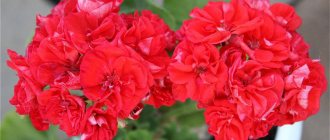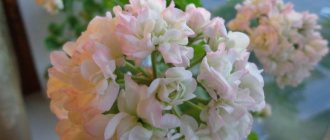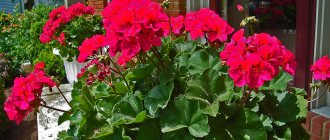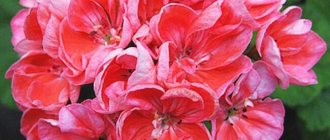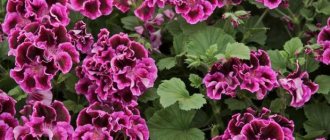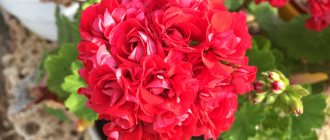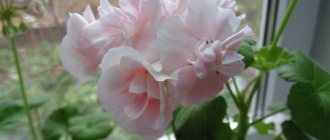Pelargonium rosebud - botanical description and classification
Pelargonium came to Europe from Africa thanks to travelers and colonialists. According to the description, it belongs to the Geraniaceae family. Various plant varieties are adapted for growing indoors and in open ground.
Pelargonium rosebud
Due to the diversity of flower varieties, as well as the many hybrid varieties, today there is no clear classification. The most common types of pelargonium are:
- zonal;
- ivy-leaved or ampelous;
- royal;
- angels;
- unique;
- fragrant.
Geranium rosebud, otherwise called Rosaceae, arose due to an accidental mutation in the 18th century. Subsequent breeding work was carried out purposefully, as a result of which a huge variety of varieties of rose-shaped pelargoniums were bred.
What care does rosebud geranium need?
With proper care of the plant in a greenhouse or at home, pelargonium pleases with its beautiful appearance and abundant flowering.
Basic requirements for caring for rosebud geranium:
- shading from direct sunlight;
- moderate watering.
Violation of these rules can cause a deterioration in the appearance of the flower and a decrease in the intensity of flowering. Do not flood a houseplant with water; it may die as a result. In winter, if the plant is not in the room, it needs to create a suitable temperature regime - not lower than +10ºС.
It is best to transplant a flower in mid-spring. In the future, care will be reduced to timely moistening of the soil. You can purchase ready-made soil designed specifically for pelargoniums, or you can make it yourself.
The soil mixture should contain the following components:
- humus;
- peat;
- coarse sand;
- perlite;
- turf land.
Maintaining the decorative appearance of the plant requires periodic renewal, which must be carried out no later than once every 5 years.
Indoor pelargonium, if possible, can be transplanted into open ground in the spring and summer. This will allow the plant to bloom beautifully and luxuriantly in the warm season. In the fall, the geranium can be replanted in a pot and brought indoors.
Varieties of indoor plants
How to care for ampelous geraniums at home
Geranium varieties are distinguished by their lush flowering and a wide palette of colors. Not only flowers, but also leaf blades of some varieties can have a decorative appearance.
A huge number of rosebund pelargoniums have been bred
- Rose of Amsterdam
"Rose of Amsterdam" is one of the miniature, fast-growing varieties. Terry inflorescences are painted in white and pink shades. As the plant ages, the buds become more and more vibrant.
- Supreme
"Rosebud Supreme" is distinguished by rich crimson, densely double flowers with white undersides of the petals. Under proper conditions, flowering can continue year-round.
For reference! Supreme typically enters the flowering season later than similar varieties.
- Apple Blossom
"Apple Blossom Rosebud" is one of the oldest varieties of pelargonium. It has, as the name suggests, a delicate apple green coloration with a rich pink edging.
The variety is quite whimsical and requires shading, frequent fertilization and pruning.
- Vectis
“Vectis Rosebud” is a miniature zonal variety with large wine-red buds and a light underside of the petals. Lush, disheveled inflorescences last a long time. The leaves are dark green.
- Red pelargonium "Rosebud Red"
Pelargonium Rosebud Red with deep red flowers. The inflorescences are densely packed and form almost continuously throughout the year. Does not require molding.
- Beverly park
Pelargonium with double, apricot-colored buds with a lighter, almost white edging. The leaf blades are green, darkening towards the central part.
For reference! Beverly Park - suitable for those who prefer a non-standard red color scheme.
- Princess Mary
Compact early flowering variety. The leaves are uniform green. The inflorescences are dense, greenish-white. As they fade, the petals turn pink.
- Rushmoor Golden Rosebud
Rushmoor Gold features bright pink flowers that are not too densely packed. The leaf blades are light, golden-green in color.
A variety of varieties of rosebud pelargonium with photos
Rosebud geranium has many varieties. Here are some of the most popular ones:
- Variety Denise has an original, memorable color. The peach coloring of the middle part of the petals and the beautiful pink edging are striking. This type of rosebud geranium has one of the largest buds among all varieties. The bush is of medium size.
- Complex colors of the Apple blossom rosebud variety (Apple blossom Rosebud). They have white petals with a slight green tint. Their border is pink. This variety is considered capricious. To get a beautiful bush, it needs to be shaped. The plant begins to bloom late.
- Pelargonium rosebud Margaretha blooms in such a way that the flowers are arranged in several rows. They practically look like a bouquet. Which consists of not fully blossomed roses.
- Millfield Rose – is a hybrid variety with large buds. The flowers have a pale pink tint. In hot conditions, additional watering is necessary.
- Pelargonium rosebud Mary represents one of the compact flowers.
- Australien Pink Rosebud (Pelargonium Australian Pink Rosebud) stands out because the flowers have soft pink petals.
- At the geranium Prins Nikolai large white double flowers.
- One of the varieties that is characterized by early and long flowering is Pelargonium rosebud. Queen Ingrid.
Caring for rosebud pelargonium at home
Varieties of geraniums - what lemon and field geraniums look like
Rose geranium requires special treatment; it should be cared for by following certain rules. By adhering to them, you can achieve long-lasting lush flowering.
Watering should be regular and moderate
Illumination and temperature conditions
Pelargonium rosebud tolerates bright sunlight and partial shade. On a personal plot, it can be planted on an alpine hill, placed in a hanging flowerpot, or placed in a flowerpot in the shade of trees.
Note! When there is a lack of lighting, geranium foliage becomes lighter and may fall off, the stems become elongated, and flowering is delayed or does not occur at all.
The flower does not tolerate heat very well. Maximum permissible temperature 28 °C. Otherwise, the plant will become lethargic, and the flowers will fall off earlier than expected.
Watering rules and humidity
Pelargonium bushes should be watered sparingly. The flower tolerates drought much easier than excessive moisture and stagnation of water.
The plant almost does not react to a decrease in the level of air humidity in the room. In rare cases, the edges of the leaves may dry out.
It is not advisable to spray pelargonium. The accumulation of moisture on fuzzy leaves can cause them to rot. You can humidify the air using a tray with pebbles and water.
Fertilizing and soil quality
Soil for rosebud geranium when caring at home can be purchased in specialized stores or mixed with your own hands. Taking a universal soil mixture, you can add perlite and sand to it to achieve better air permeability.
Self-preparation of soil involves the following proportions of components:
- peat - 2 parts;
- turf soil - 4 parts;
- river sand and perlite - 1 part each;
- humus - 2 parts.
It is recommended to feed the flower from the end of February. The application of nitrogen-containing fertilizers will allow the bush to gain green mass. Closer to the onset of the flowering period, they begin to add potassium and phosphorus to the fertilizing.
Rosebud pelargonium requires feeding
Flower container size
Flowerpots for rose-shaped geraniums are selected to be small, made of unglazed ceramics. The soil in such a container will dry out better and the roots will receive enough air.
Pruning and replanting
Rosebud pelargonium is pruned twice a year. In autumn, old shoots that have shed their leaves are cut off, and elongated stems are shortened by at least a third. In spring, only gentle pinching is done, otherwise the plant may not bloom on time.
Replanting is carried out as the bush grows, but at least once every 2 years. You can tell that the pots need to be replaced by the roots coming out through the drainage holes.
Transplantation can also be carried out for the purpose of propagation by separating independent young bushes. It is recommended to carry out the procedure in the spring.
Comparison with tulip-shaped
There are many types of geranium varieties, as well as rosebud geranium, which pleases with its magnificent inflorescences, there is also tulip-shaped geranium.
The petals of tulip geraniums are shaped like unopened tulip buds. Flower buds are always collected in clusters of several pieces. In one inflorescence you can count from 15 to 30 buds. This creates a spectacular “flower cap” over the entire area of the pelargonium.
The leaves of tulip-shaped geranium are quite hard and shiny . It grows in height from 30 to 70 centimeters, depending on the variety.
Rosebud geranium is an amazingly beautiful flower that blooms for a long time and luxuriantly at home. Although the plant is not considered picky, it should always be treated with attention.
Features of plant flowering
Caring for ampelous geranium or ivy-leaved pelargonium: diseases and pests
Without its luxurious inflorescences, geranium looks unattractive. You can achieve abundant flowering from it by providing suitable conditions.
Typically, pelargonium blooms in spring and summer. With the onset of the autumn-winter period, only those plants for which the optimal lighting regime has been created will bloom. When kept on a southern or western window, the inflorescences may not leave the bush throughout the summer. But it is worth considering that without proper rest they will gradually become smaller, less lush and bright.
In appearance, the inflorescences and the flowers of rosebud geranium themselves may differ depending on what varieties and species were used when breeding this particular plant. The buds of some hybrids are very dense and most similar to roses, like those of red rosebud pelargonium. In other varieties, the buds may be more disheveled and loose.
Pelargonium Zonal rosebud Survivor Idols, Rosalinda
All vegetative plants marked "PLANT FOR SPRING SALES"
are being prepared for distribution in the spring with 100% advance payment for the order. The price of an item in the vegetative plants section is the full cost of the item. Prepayment is a necessary measure that gives us a guarantee for the subsequent purchase of plants by the customer. Payment for delivery of the parcel is paid before sending the order.
The supply of planting material is limited!
ATTENTION!
Suppliers of seedlings from Holland reserve the right to change the assortment up to 15% at the time of delivery; this can happen if any variety has not grown, disappeared or become ill. In such cases, selection and replacement is at the discretion of the customer, or compensation in monetary terms for the missing variety.
The minimum total order of vegetative plants is 14 pcs.
Important!
All seedlings are expected from Holland in the first half of February, so the final price for the plant may be adjusted depending on the exchange rate at the time of receipt.
Payment
Payment must be made within 7 days after placing the order. After payment, you must send all payment details by email: amount, date of payment, last digits of the card, you can have a photo or scan of the receipt. If there is a need to additionally order any more plants, this can be done in subsequent orders with the obligatory note in the comments field to the order “Combine with No...”. Number of plants to order
To send your order, we use two types of mailing boxes depending on the number of plants ordered: L size boxes: 14–18 pcs. XL size boxes: 30–35 pcs. For delivery by bus, the number of plants is not limited. To send by mail, in addition to vegetative plants, the order can include goods from the “Flower Seeds” and “Professional Fertilizers” sections, except for those in 500 g packaging. For delivery by bus, any other product can be included in the order. Travel time
Travel time should not exceed 8–10 days, as longer periods can be detrimental to plants. 10 days are already risks! All questions regarding the time the order is in transit and the cost of delivery should be agreed upon independently in your Russian Post offices, or on the Post website: https://www.pochta.ru/parcels. Before placing an order, it is advisable to use the Russian Post calculator to calculate how much it will cost to deliver the parcel and how many days it will be in transit. The weight of one plant including packaging is approximately 250 g. The weight of a box with an average order (16–18 plants) is 4500–5000 kg.
Quality of vegetative plants The arrival of cuttings from Holland is expected on February 5–15, after which they are all planted in 250 ml containers. The substrate in which the cuttings are planted consists of universal soil, professional peat substrate with the addition of agroperlite and sand. Before the start of mailings, plants are grown, formed and grown from the concept of “cutting” for a minimum of one month and a maximum of two.
All plants have a well-developed root system and a branched above-ground part. Plants are carefully prepared for shipment and securely packaged. A week before departure, they are treated with fungicides to prevent rotting during the journey. On the eve of dispatch, we treat it with professional anti-stress preparations for better preservation during shipment. Before shipping, if desired, the plants are photographed and the photo is sent to the customer. The packaging of plants before shipping is very careful, time-tested. Containers with plants are packed so that when the box is turned over, the soil does not spill, the earthen ball is not disturbed, and the leaves are not damaged. Next, the plants are packaged in a cardboard tube and secured very firmly with tape. Due to the painstaking, time-consuming process of packaging our plants, our supply for postal parcel delivery is limited. Start of mailings Mailings, depending on weather conditions at that time, will begin approximately from March 10-15, for southern regions, from March 25 in more northern regions. Orders from customers from the southern region, upon agreement, can be sent by bus at an earlier date - during February at above-zero temperatures. The timing of orders will be individually agreed upon with each person, taking into account all the customer’s wishes, weather conditions and our capabilities. Delivery
WE DO NOT SEND VEGETATIVE PLANTS BY TRANSPORT COMPANIES!
Most transport companies were prohibited from accepting cargo if the package contains plants - rooted cuttings, seedlings, potted varieties of flowers, etc., since they cannot be responsible for their safety in transit. If the inventory of the shipped cargo indicates cuttings, seedlings and other living plants, such cargo will not be accepted!
Sending of vegetative plants is carried out by postal services, regular passenger buses and self-pickup. In Krasnodar, once a week, in agreement with the client, orders are delivered by our transport.
1. Russian Post
The price for delivery by Russian Post parcels will be calculated individually using the Russian Post calculator, depending on the estimated cost, weight and destination. Sending by 1st class parcel is possible - this is an expedited type of air delivery. Rates for this type of delivery are more expensive, with restrictions on the weight and size of the mail box. This box will fit no more than 6 plants. We have an estimated cost of a parcel with vegetative plants: 100 rubles. If you want to increase the estimated cost of the parcel, then you must also notify us about this when placing your order in the “Comment on the order” field. When choosing delivery by Russian Post, before sending the order, you will need to pay for delivery; all buyers will be informed about this by phone or in writing by e-mail. The average price of a parcel is 450–600 rubles. The price indicated is approximate, it depends on the shipping distance, weight and estimated cost of the shipment. The price includes a shipping box and individual packaging of plants. 2. Regular passenger buses
Dispatch in accordance with bus station schedules. Dispatch from Slavyansk-on-Kuban and Krasnodar. Delivery to the bus station in Krasnodar 200 rubles. At all bus stations in Krasnodar there is a mandatory inspection of luggage that will be placed in the cargo compartments of buses, the price of such inspection is 100 rubles. An amount of 300 rubles. Payment will be required before the order is shipped. For delivery services by regular buses, the buyer pays independently upon receipt of the goods. Attention! Before placing an order with bus delivery, you must check at your bus stations about the availability of flights through your locality from Slavyansk-on-Kuban and Krasnodar, as well as their schedule.
3. Pickup
Before arriving, be sure to inform us by phone about your visit two days in advance so that the order is completed before the client arrives. All orders for pickup must be placed in advance on the IM website. Guarantees
We cannot be responsible for the safety of plants in transit. Before placing an order, analyze all the risks associated with delivery. This is especially true for remote regions.
Recommendations for plant adaptation after receipt
All plants are subject to careful inspection. Pay special attention to those plants that show signs of decay. All rotten branches are carefully trimmed, the sections are treated with charcoal or crushed activated carbon tablets. Apply Previkur under the root - 1 ml per 1 liter, treat the leaf with the fungicide Quadris - 1.2 ml per 1 liter of water (without getting into the ground). Alternative fungicide for suppressing pathogenic microbes and bacteria Topsin M, leaf treatment, consumption 1, 1.5 g. per 1 liter of water. In case of rotting of the root system and extensive damage to the aerial part by putrefactive processes, treat one leaf at a time and pour the biobactericide “Fitolavin” under the root: consumption 2 ml per 1 liter of water. When applying foliar treatments, using the proposed fungicides, add an anti-stress drug based on amino acids “Amnokat” to the tank mixture - consumption of 2.5 ml per 1 liter of water, or “Foliton” - 2 ml per 1 liter of water. Isabion is also effective - 4 ml per 1 liter of water. Repeat this procedure after 8–10 days. Healthy plants, but yellowed during travel from lack of light, should be placed in a bright place without direct sunlight for the first week. Treat in one mixture “Aminokat” (“Foliton”, “Megafol”, “Isabion” - one of the available ones) plus “Epin”. After 4 days, to completely restore the foliage, treat with iron chelate “Ferovit” according to the instructions. It is sold in retail chains. Or “Brexil Fe” - the norm is 1 g per 1 liter of water, an overdose is not advisable, since the plants are still weakened. Or “Kelik mix” - 1.5 ml per 1 liter of water. “Ferrofort Fe”, “Rexolin ABC” are very good - 1 g per 1 liter of water, treatment per sheet. If after 5–6 days the foliage does not recover, repeat the treatment with iron chelate again. Root feeding for relatively well-preserved seedlings should begin 3–4 days after receiving calcium nitrate 1.5 g per 1 liter of water, a week later with potassium monophosphate 1 g per 1 liter of water. Start feeding rotten plants after therapy no earlier than 7–9 days after receiving them; take the dosage of fertilizers at half the normal rate.
Before transplanting, you need to make sure that the cutting has withstood transportation and adaptation well, and that its leaves and root system continue to develop confidently. A pot for the plant should be selected with a volume no more than 2.5 times its previous volume. For pelargonium, the pot is no more than 0.6 liters. For ampelous petunia, begonia and other plants, no more than 1 liter is enough. Transfer to the final pot (plant pot) after the plant has grown well in the intermediate one.
Flower propagation methods
Rosebud geranium reproduces just like any other variety. Most often, two methods are used: cuttings and sowing seeds.
Cuttings can be immediately planted in the ground
Reproduction by cuttings
This method can be used at any time of the year. For germination, lateral shoots with 2-3 leaves are cut from the bush.
A cut of the cutting is dipped in crushed activated carbon and placed in a shaded place for several hours. After this procedure, the cuttings can be placed in water to germinate roots.
Propagation by seeds
Propagation of geraniums by sowing seed material is a rather labor-intensive process. But in this case you can get many young viable plants.
The seeds are planted at a distance of 5 cm from each other, kept in a growth stimulator. A greenhouse is built over the crops, placed on a lighted windowsill, after which it is regularly ventilated and watered by spraying.
Additional Information! To speed up the appearance of sprouts, the seeds can be rubbed on sandpaper.
Features of reproduction
To propagate rosebud geranium, the seed method and cuttings are used.
Seminal
- Wrap the planting material in damp gauze. Leave it for 7-10 days in a room where there is no dry air. During this time, monitor the moisture content of the fabric.
- When the seeds swell, transplant them into the prepared substrate. Cover the container with polyethylene and water the soil regularly.
- As soon as a sprout appears and 4 leaves grow on it, the film can be removed and the plants can be planted in separate pots.
- The grown plant is placed in a container of suitable volume. It is better to use a clay pot, as this material allows air to pass through better. Drainage laid in a layer of 3 cm will prevent rotting of the root system.
Cuttings
Geranium cuttings can be carried out throughout the year, but the best time is from March to July. Procedure:
Cut a semi-lignified cutting from the mother plant, which will have 3-5 internodes, since the green and grassy one will not take root. Use only purchased soil, adding vermiculite to it. Pour the nutrient mixture into transparent plastic cups and plant the prepared cuttings
Preparation of planting material includes cutting, removing leaves and air drying for 30-40 minutes. In the first days, water carefully so as not to overwater or overdry. Rooting of cuttings occurs under lamps for 2-3 weeks. As soon as the first roots form, you can add more fertile soil... The familiar geranium, this unpretentious and incredibly beautiful flower, is famous for its most amazing variety of species and varieties.
How to choose what to plant in the garden or on the windowsill? Our articles will help you navigate. From them you can learn about the perennial Peony and the annual Robert, about Rosanna, which blooms all summer, about hybrids of the Angel variety and the interesting Plenum geranium, read what is good about Max Fry, how to care for the fragrant Lemon and fragrant, how to grow black geranium.
The familiar geranium, this unpretentious and incredibly beautiful flower, is famous for its most amazing variety of species and varieties. How to choose what to plant in the garden or on the windowsill? Our articles will help you navigate. From them you can learn about the perennial Peony and the annual Robert, about Rosanna, which blooms all summer, about hybrids of the Angel variety and the interesting Plenum geranium, read what is good about Max Fry, how to care for the fragrant Lemon and fragrant, how to grow black geranium.
Growing problems, diseases and pests
Geraniums may look unhealthy for several main reasons, which are listed below. To protect the flower, they resort to regular inspection:
- Yellowing of the leaves indicates excessive dryness of the air in the room and lack of lighting. You can cope with the problem by moving the pots with geraniums to a suitable place.
- Lethargy of leaves and stems means an excess of moisture at the roots of the plant. In such a situation, it is important to adjust watering.
- Rose flowers dry and wither when the plant is infected with a fungal infection. Treating the bush twice with Fitosporin at weekly intervals may help.
- When a bacterial disease occurs, geranium leaves become covered with brown spots. The solution is urgent transplantation into disinfected soil, treatment with fungicides and regulation of the watering regime.
- Although the plant repels most insect pests, it can be destroyed by aphids or whiteflies. Get rid of them using appropriate insecticides.
Rosebud geranium blooms very luxuriantly
With proper care, the gardener will not have to face problems when growing pelargonium.
The beauty of rosebud geranium flowers, which look like miniature, almost toy roses, is unique. The appearance of the lush inflorescences of pink pelargonium justifies and covers all the efforts that were made to grow the plant in a home or apartment.
